“Madame Curie” redirects here. For the 1943 biographical film about her, see Madame Curie (film).

This article is about the chemist and physicist. For the schools named after her, see École élémentaire Marie-Curie and Marie Curie High School.

Marie Skłodowska Curie (7 November 1867 – 4 July 1934) was a physicist and chemist of Polish upbringing and, subsequently, Frenchcitizenship. She was a pioneer in the field of radioactivity, the first person honored with two Nobel Prizes,[1] receiving one in physics and later, one in chemistry. She was the first woman to serve as professor at the University of Paris.
She was born Maria Skłodowska in Warsaw (then Vistula Country, Russian Empire; now Poland) and lived there until she was twenty-four years old. In 1891 she followed her elder sister, Bronisława, to study in Paris, where she obtained her higher degrees and conducted her subsequent scientific work. She founded the Curie Institutes in Paris and Warsaw. Her husband, Pierre Curie, was a Nobel co-laureate of hers, being awarded a Nobel prize in physics at the same time. Her daughter, Irène Joliot-Curie, and son-in-law, Frédéric Joliot-Curie, also received Nobel prizes.
Her achievements include the creation of a theory of radioactivity (a term she coined [2]), techniques for isolating radioactive isotopes, and the discovery of two new elements, polonium and radium. Under her direction, the world’s first studies were conducted into the treatment of neoplasms (cancers), using radioactive isotopes.
While an actively loyal French citizen, she never lost her sense of Polish identity. She named the first new chemical element that she discovered (1898) polonium for her native country,[3] and in 1932 she founded a Radium Institute (now the Maria Skłodowska–Curie Institute of Oncology) in her home town, Warsaw, which was headed by her sister, Bronisława, who was a physician.
Early life
Maria Skłodowska was born in Warsaw, Poland, on 7 November 1867, the fifth and youngest child of well-known teachers Bronisława and Władysław Skłodowski. Maria’s older siblings were Zofia (born 1862), Józef (1863), Bronisława (1865), and Helena (1866).
Maria’s grandfather Józef Skłodowski had been a respected teacher in Lublin, where he had taught the youngBolesław Prus.[4] Her father Władysław Skłodowski taught mathematics and physics, subjects that Maria was to pursue, and he successively, was director of two Warsaw gymnasia for boys, in addition to lodging boys in the family home. Her mother, Bronisława, operated a prestigious Warsaw boarding school for girls. She suffered fromtuberculosis and died when Maria was twelve.
Maria’s father was an atheist and her mother a devout Catholic.[5] Two years earlier, Maria’s oldest sibling, Zofia, had died oftyphus. The deaths of her mother and sister, according to Robert William Reid, caused Maria to give up Catholicism and becomeagnostic.[6]
When she was ten years old, Maria began attending the boarding school that her mother had operated while she was well; next Maria attended a gymnasium for girls, from which she was graduated on 12 June 1883. She spent the following year in the countryside with her father’s relatives, and the next with her father in Warsaw, where she performed some tutoring.
On both the paternal and maternal sides, the family had lost their property and fortunes through patriotic involvements in Polish national uprisings. This condemned each subsequent generation, including that of Maria, her elder sisters, and brother to a difficult struggle to get ahead in life.
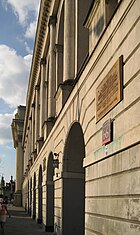
 Krakowskie Przedmieście 66
Krakowskie Przedmieście 66, nearWarsaw’s Old Town (in the distance). It was here, in 1890–91, that Skłodowska conducted her first scientific work.
Maria made an agreement with her sister, Bronisława, that she would give her financial assistance during Bronisława’s medical studies in Paris, in exchange for similar assistance two years later.[8] In connection with this, she took a position as governess. First with a lawyer’s family in Kraków, then for two years inCiechanów with a landed family, the Żorawskis, who were relatives of her father. While working for the latter family, she fell in love with their son, Kazimierz Żorawski, which was reciprocated by this future eminent mathematician. His parents, however, rejected the idea of his marrying the penniless relative and Kazimierz was unable to oppose them. Maria lost her position as governess.
.


Kazimierz Żorawski, in later life
At the beginning of 1890, Bronisława, a few months after she married Kazimierz Dłuski, invited Maria to join them in Paris. Maria declined because she could not afford the university tuition and was still counting on marrying Kazimierz Żorawski. She returned home to her father, with whom she remained till the Fall of 1891, tutoring, studying at the clandestine Floating University, and beginning her practical scientific training in a laboratory at the Museum of Industry and Agriculture. It was run by her cousin Józef Boguski, who had been assistant in St. Petersburg to the great Russian chemist Dmitri Mendeleyev.[10]
In October 1891, at her sister’s insistence and after receiving a letter from Żorawski, in which he definitively broke his relationship with her, she decided to go to France after all.[5]
Maria’s loss of the relationship with Żorawski was tragic for both. He soon earned a doctorate and pursued an academic career as a mathematician, becoming a professor and rector of Kraków University and president of the Warsaw Society of Learning. Still, as an old man and a mathematics professor at the Warsaw Polytechnic, he would sit contemplatively in front of the statue of Maria Skłodowska, which had been placed before the Radium Institute that she had founded.[11] In Paris, Maria briefly found ****ter with her sister and brother-in-law before renting a primitive garret [12] and proceeding with her studies of physics, chemistry, and mathematics at the Sorbonne (the University of Paris).
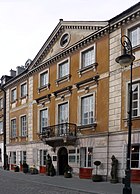

Maria Skłodowska’s birthplace on
ulica Freta in Warsaw’s “New Town”
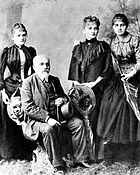

Władysław Skłodowski with daughters
(from left)Maria, Bronisława, Helena
Sorbonne
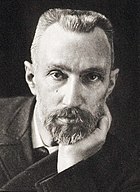

Pierre Curie
Skłodowska studied during the day and tutored evenings, barely earning her keep. In 1893 she was awarded a degree in physics and began work in an industrial laboratory at Lippman’s. Meanwhile she continued studying at the Sorbonne, and in 1894, earned a degree in mathematics.
In the same year Pierre Curie entered her life. He was an instructor in the School of Physics and Chemistry, the École Supérieure de Physique et de Chimie Industrielles de la Ville de Paris (ESPCI). Skłodowska had begun her scientific career in Paris with an investigation of the magnetic properties of various steels; it was their mutual interest in magnetism that drew Skłodowska and Curie together.[13]
Her departure for the summer to Warsaw only enhanced their mutual feelings for each other. She still was laboring under the illusion that she would be able to return to Poland and work in her chosen field of study. When she was denied a place at Kraków University merely because she was a woman,[14] however, she returned to Paris. Almost a year later, in July 1895, she and Pierre Curie married, and thereafter the two physicists hardly ever left their laboratory. They shared two hobbies, long bicycle trips and journeys abroad, which brought them even closer. Maria had found a new love, a partner, and scientific collaborator upon whom she could depend.[14]
New elements
In 1896 Henri Becquerel discovered that uranium salts emitted rays that resembled X-rays in their penetrating power. He demonstrated that this radiation, unlike phosphorescence, did not depend on an external source of energy, but seemed to arise spontaneously from uranium itself. Becquerel had, in fact, discovered radioactivity.
Skłodowska–Curie decided to look into uranium rays as a possible field of research for a thesis. She used a clever technique to investigate samples. Fifteen years earlier, her husband and his brother had invented the electrometer, a sensitive device for measuring electrical charge. Using the Curie electrometer, she discovered that uranium rays caused the air around a sample to conduct electricity.[15] Using this technique, her first result was the finding that the activity of the uranium compounds depended only on the quantity of uranium present. She had shown that the radiation was not the outcome of some interaction of molecules, but must come from the atom itself. In scientific terms, this was the most important single piece of work that she conducted.[16]
Skłodowska–Curie’s systematic studies had included two uranium minerals, pitchblende and torbernite. Her electrometer showed that pitchblende was four times as active as uranium itself, and chalcolite twice as active. She concluded that, if her earlier results relating the quantity of uranium to its activity were correct, then these two minerals must contain small quantities of some other substance that was far more active than uranium itself.[17]
The idea [writes Reid] was her own; no one helped her formulate it, and although she took it to her husband for his opinion she clearly established her ownership of it. She later recorded the fact twice in her biography of her husband to ensure there was no chance whatever of any ambiguity. It [is] likely that already at this early stage of her career [she] realized that… many scientists would find it difficult to believe that a woman could be capable of the original work in which she was involved.[18]
In her systematic search for other substances beside uranium salts that emitted radiation, Skłodowska–Curie had found that the element thorium likewise, was radioactive.
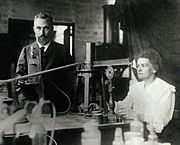

Pierre and Marie Curie in their Paris laboratory, before 1907
She was acutely aware of the importance of promptly publishing her discoveries and thus establishing her priority. Had not Becquerel, two years earlier, presented his discovery to the Académie des Sciences the day after he made it, credit for the discovery of radioactivity, and even a Nobel Prize, would have gone to Silvanus Thompson instead. Skłodowska–Curie chose the same rapid means of publication. Her paper, giving a brief and simple account of her work, was presented for her to the Académie on 12 April 1898 by her former professor, Gabriel Lippmann.[19]
Even so, just as Thompson had been beaten by Becquerel, so Skłodowska–Curie was beaten in the race to tell of her discovery that thorium gives off rays in the same way as uranium. Two months earlier, Gerhard Schmidt had published his own finding in Berlin.[20]
At that time, however, no one else in the world of physics had noticed what Skłodowska–Curie recorded in a sentence of her paper, describing how much greater were the activities of pitchblende and chalcolite compared to uranium itself: “The fact is very remarkable, and leads to the belief that these minerals may contain an element which is much more active than uranium.” She later would recall how she felt “a passionate desire to verify this hypothesis as rapidly as possible.”[21]
Pierre Curie was sure that what she had discovered was not a spurious effect. He was so intrigued that he decided to drop his work on crystals temporarily and to join her. On 14 April 1898 they optimistically weighed out a 100-gram sample of pitchblende and ground it with a pestle and mortar. They did not realize at the time that what they were searching for was present in such minute quantities that they eventually would have to process tonnes of the ore.[21]
Since they were unaware of the deleterious effects of radiation exposure attendant on their chronic unprotected work with radioactive substances, Skłodowska–Curie and her husband had no idea what price they would pay for the effect of their research upon their health.[14]


Pierre, Irène, Marie Curie
In July 1898, Skłodowska–Curie and her husband published a paper together, announcing the existence of an element which they named “polonium”, in honor of her native Poland, which would for another twenty years remain partitioned among three empires. On 26 December 1898 the Curies announced the existence of a second element, which they named “radium” for its intense radioactivity — a word that they coined.
Pitchblende is a complex mineral. The chemical separation of its constituents was an arduous task. The discovery of polonium had been relatively easy; chemically it resembles the element bismuth, and polonium was the only bismuth-like substance in the ore. Radium, however, was more elusive. It is closely related, chemically, to barium, and pitchblende contains both elements. By 1898 the Curies had obtained traces of radium, but appreciable quantities, uncontaminated with barium, still were beyond reach.[22]
The Curies undertook the arduous task of separating out radium salt by differential crystallization. From a ton of pitchblende, one-tenth of a gram ofradium chloride was separated in 1902. By 1910 Skłodowska–Curie, working on without her husband, who had been killed accidentally in 1906, had isolated the pure radium ****l.[23]
In an unusual decision, Marie Skłodowska–Curie intentionally refrained from patenting the radium-isolation process, so that the scientific community could do research unhindered.[24]
In 1903, under the supervision of Henri Becquerel,[25] Marie was awarded her DSc from the University of Paris
Nobel Prizes


1911 photograph of Maria Skłodowska Curie for her second Nobel Prize, awarded for her work inchemistry
In 1903, the Royal Swedish Academy of Sciences awarded Pierre Curie, Marie Curie and Henri Becquerel the Nobel Prize in Physics, “in recognition of the extraordinary services they have rendered by their joint researches on the radiation phenomena discovered by Professor Henri Becquerel.”
Skłodowska–Curie and her husband were unable to go to Stockholm to receive the prize in person, but they shared its financial proceeds with needy acquaintances, including students.[14]
On receiving the Nobel Prize, Marie and Pierre Curie suddenly became very famous. The Sorbonne gave Pierre a professorship and permitted him to establish his own laboratory, in which Skłodowska–Curie became the director of research.
In 1897 and 1904, respectively, Skłodowska–Curie gave birth to their daughters, Irène and Eve Curie. She later hired Polish governesses to teach her native ******** to them, and send or take them on visits to Poland.[26]


Maria Skłodowska–Curie’s 1911Nobel Prize for Chemistry diploma
Skłodowska–Curie was the first woman to be awarded a Nobel Prize. Eight years later, she would receive the 1911 Nobel Prize in Chemistry, “in recognition of her services to the advancement of chemistry by the discovery of the elements radium and polonium, by the isolation of radium and the study of the nature and compounds of this remarkable element.”
A month after accepting her 1911 Nobel Prize, she was hospitalized with depression and a kidney ailment.
Skłodowska–Curie was the first person to win or share two Nobel Prizes. She is one of only two people who have been awarded a Nobel Prize in two different fields, the other being Linus Pauling (for Chemistry and for Peace). Nevertheless, in 1911 the French Academy of Sciences refused to abandon its prejudice against women, and she failed by two votes to be elected as a member. Instead, Édouard Branly, an inventor who had helped Guglielmo Marconi develop the wireless telegraph was elected.[27] It would be her doctoral student, Marguerite Perey, who would become the first woman elected to the Academy — in 1962, over half a century later.
Pierre’s death
On 19 April 1906 Pierre was killed in a street accident. Walking across the Rue Dauphine in heavy rain, he was struck by a horse-drawn vehicle and fell under its wheels, his skull was fractured. While it has been speculated that previously, he may have been weakened by prolonged radiation exposure, it has not been proven that this was the cause of the accident.
Skłodowska–Curie was devastated by the death of her husband. She noted that, as of that moment she suddenly had become “an incurably and wretchedly lonely person”. On 13 May 1906 the Sorbonne physics department decided to retain the chair that had been created for Pierre Curie and they entrusted it to Skłodowska–Curie together with full authority over the laboratory. This allowed her to emerge from Pierre’s shadow. She became the first woman to become a professor at the Sorbonne, and in her exhausting work regime, sought a meaning for her life.


Paul Langevin in later life
Recognition for her work grew to new heights, and in 1911 the Royal Swedish Academy of Sciences awarded her a second Nobel Prize, this time for Chemistry. A delegation of celebrated Polish men of learning, headed by world-famous novelist, Henryk Sienkiewicz, encouraged her to return to Poland and continue her research in her native country.[14]
In 1911, it was revealed that during 1910–11 Skłodowska–Curie had conducted an affair of about a year’s duration with physicist Paul Langevin, a former student of Pierre Curie.[28] He was a married man who was estranged from his wife. This resulted in a press scandal that was exploited by her academic opponents. Despite her fame as a scientist working for France, the public’s attitude tended toward xenophobia—the same that had led to the Dreyfus Affair-which also fueled false speculation that Skłodowska–Curie was Jewish. She was five years older than Langevin and was portrayed in the tabloids as a home-wrecker.[29] Later, Skłodowska–Curie’s granddaughter, Hélène Joliot, married Langevin’s grandson, Michel Langevin.
Skłodowska–Curie’s second Nobel Prize, in 1911, enabled her to talk the French government into funding the building of a private Radium Institute (Institut du radium, now the Institut Curie), which was built in 1914 and at which research was conducted in chemistry, physics, and medicine. The Institute became a crucible of Nobel Prize winners, producing four more, including her daughter Irène Joliot-Curie and her son-in-law, Frédéric Joliot-Curie.
World War I
World War I
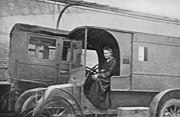

Curie in a World War I mobile X-ray vehicle
During World War I, Skłodowska-Curie pushed for the use of mobile radiography units, which came to be popularly known as petites Curies (“Little Curies”), for the treatment of wounded soldiers. These units were powered using tubes of radium emanation, a colorless, radioactive gas given off by radium, later identified as radon. Skłodowska-Curie provided the tubes of radium, derived from the material she purified. Also, promptly after the war started, she donated the gold Nobel Prize medals she and her husband had been awarded, to the war effort.
Post-war years
In 1921, Skłodowska-Curie was welcomed triumphantly when she toured the United States to raise funds for research on radium. These distractions from her scientific labors and the attendant publicity, caused her much discomfort, but provided resources needed for her work. Her second American tour in 1929 succeeded in equipping the Warsaw Radium Institute, founded in 1925 with her sister, Bronisława, as director.
In her later years, Skłodowska-Curie headed the Pasteur Institute and a radioactivity laboratory created for her by the University of Paris.
Death
Skłodowska–Curie visited Poland a last time in the spring of 1934.[14] Only a couple of months later, Skłodowska-Curie died. Her death on 4 July 1934 at the Sancellemoz Sanatorium inPassy, in Haute-Savoie, eastern France, was from aplastic anemia, almost certainly it was contracted from exposure to radiation. The damaging effects of ionizing radiation were not then known, and much of her work had been carried out in a shed, without taking any safety measures. She had carried test tubes containing radioactive isotopes in her pocket and stored them in her desk drawer, remarking on the pretty blue-green light that the substances gave off in the dark.[citation needed]
She was interred at the cemetery in Sceaux, alongside her husband Pierre. Sixty years later, in 1995, in honor of their achievements, the remains of both were transferred to the Paris Panthéon. She became the first woman so honored.
Her laboratory is preserved at the Musée Curie.
Due to their levels of radioactivity, her papers from the 1890s are considered too dangerous to handle. Even her ****book is highly radioactive. They are kept in lead-lined boxes and those who wish to consult them, must wear protective clothing.[30]
Legacy


Statue, Maria Curie-Skłodowska University,Lublin, Poland
The physical and societal aspects of the work of the Curies contributed substantially to shaping the world of the twentieth and twenty-first centuries. Cornell University professor L. Pearce Williams observes:
The result of the Curies’ work was epoch-making. Radium’s radioactivity was so great that it could not be ignored. It seemed to contradict the principle of theconservation of energy and therefore forced a reconsideration of the foundations of physics. On the experimental level the discovery of radium provided men likeErnest Rutherford with sources of radioactivity with which they could probe the structure of the atom. As a result of Rutherford’s experiments with alpha radiation, thenuclear atom was first postulated. In medicine, the radioactivity of radium appeared to offer a means by which cancer could be successfully attacked.[23]
If the work of Maria Skłodowska–Curie helped overturn established ideas in physics and chemistry, it has had an equally profound effect in the societal sphere. In order to attain her scientific achievements, she had to overcome barriers that were placed in her way because she was a woman, in both her native and her adoptive country. This aspect of her life and career is highlighted in Françoise Giroud’s Marie Curie: A Life, which emphasizes Skłodowska’s role as a feministprecursor. She was ahead of her time, emancipated, independent, and in addition uncorrupted. Albert Einstein is reported to have remarked that she was probably the only person who was not corrupted by the fame that she had won.[31]
Awards
Marie Skłodowska-Curie was the first woman to win a Nobel prize and the first person to win two Nobel Prizes.
- Nobel Prize in Physics (1903)
- Davy Medal (1903)
- Matteucci Medal (1904)
- Nobel Prize in Chemistry (1911)
The life of famous scientists may not be luxurious. The Curies reportedly used part of their award money to replace wallpaper in their Parisian home and install modern plumbing into a bathroom.[32]
Honors
Madame Curie was decorated with the French Legion of Honor. In Poland, she had received honorary doctorates from the Lwów Polytechnic (1912), Poznań University (1922), Kraków’sJagiellonian University (1924), and the Warsaw Polytechnic (1926).
Their elder daughter, Irène Joliot-Curie, won a Nobel Prize for Chemistry in 1935 for discovering that aluminum could be made radioactive and emit neutrons when bombarded with alpha rays. Their younger daughter, Ève Curie, later wrote a biography of her mother.
In 1936, Michalina Mościcka, wife of Polish President Ignacy Mościcki, unveiled a statue of the Marie Curie in front of Warsaw’s Curie Institute, the former Radium Institute. Eight years later, the monument suffered damage from gunfire during the 1944 Warsaw Uprising. After the war, when maintenance work was being conducted, it was decided to leave these scars on the statue.[14]
In 1967, a museum devoted to Skłodowska–Curie was established in Warsaw’s “New Town”, in her birthplace on ulica Freta (Freta Street).[14]
Tributes
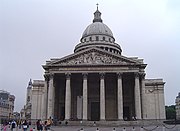
 Panthéon
Panthéon, Paris


Polish banknote
As one of the most famous female scientists to date, Marie Curie has been an icon in the scientific world and has inspired many tributes and recognitions.
In 1995, she was the first woman laid to rest under the famous dome of the Paris Panthéon, alongside her husband, Pierre Curie.
The curie (symbol Ci), a unit of radioactivity, is named in honour of her and Pierre,[33][34] as is the element with atomic number 96 — curium.
Three radioactive minerals are named after the Curies: curite, sklodowskite, and cuprosklodowskite.
Skłodowska-Curie’s likeness appeared on the Polish late-1980s inflationary 20,000-złoty banknote. Her likeness also has appeared on stamps and coins, as well as on the last French 500-franc note, before the franc was replaced by the euro.
Marie Curie was voted the “Most inspirational woman in science” in a 2022 poll carried out by New Scientist magazine on behalf of the L’Oreal UNESCO’For Women In Science’ programme. Curie received 25.1 per cent of all the votes cast, nearly twice as many as second-place Rosalind Franklin (14.2 per cent).[35][36]
Polish institutions named after Maria Skłodowska–Curie include:
- Maria Curie-Skłodowska University, in Lublin, founded in 1944;


Soviet postage stamp


Medallion, University at Buffalo
- Maria Skłodowska–Curie Institute of Oncology, in Warsaw
French institutions named after Maria Skłodowska–Curie include:
- Pierre and Marie Curie University, the largest science, technology, and medicine university in France, and the successor institution to the faculty of science at the University of Paris, where she taught; it is named in honor of her and Pierre. The university is home to the laboratory where they discovered radium.
- The Curie Institute and Curie Museum, in Paris
- In 2022, the Pierre Curie Paris Métro station was renamed the “Pierre et Marie Curie” station.
American institutions named after Maria Skłodowska–Curie include:
- Curie Community at the Loyola University Stritch School of Medicine, in Chicago, a memorial gathering room for students at the university
- In Bayside, Queens, New York, another school named for her, Marie Curie M.S. 158, specializes in science and technology; as does Curie Metropolitan High School — located in Archer Heights, on Chicago’s Southwest Side — which has a Technical, Performing Arts and IB program
- The Maria Skłodowska-Curie Medallion, a stained-glass panel created by Jozef C. Mazur, may be found at the University at Buffalo Polish Room.
Greer Garson and Walter Pidgeon starred in the 1943 U.S. Oscar-nominated film, Madame Curie, based on her life. “Marie Curie” also is the name of a character in a 1988 comedy, Young Einstein, by Yahoo Serious.
A KLM McDonnell Douglas MD-11 (registration PH-KCC) is named in her honor.[37]




















